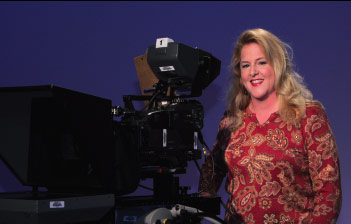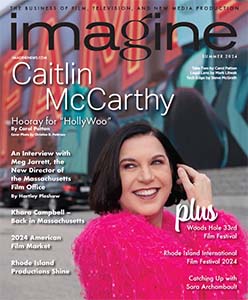By Hartley Pleshaw
Emerson College is known the world over for being a rather unique place. It was the first four-year, undergraduate, liberal arts college devoted to Communications. While the study of communications has always been central at Emerson, it has taken much of the rest of the world some time to catch up with it. Now that we live in the Age of Communications, the first college devoted to the art is more relevant and important than ever.
For decades, students have come to Emerson dreaming of careers in every form of communication, including, of course, television. The hope that an Emerson education might lead to constructive and creative work at a TV station or network burns brightly in the heart of many an Emerson student.
Now, the realization of that dream need not wait for the awarding of a degree, If you go to Emerson looking for a future at a television network, that future can be, quite literally, now.
The Emerson Television Channel is on the air. Or, more accurately, it’s on cable, sent to every Emerson dorm room, and on the Web. (It’s officially known as “Emerson College Television Channels”, taking into account its’ availability on both media.) It’s more than a club, an internship program or part of the curriculum, although it can also be said to be all those things in its own way. It is an honest-to-goodness TV network: the real thing, even before the Emerson students who staff it join the post-college real world.
Diana Barton, Emerson ’91, is the Manager of The Emerson Television Channels. According to Diana, its creation was the natural progression of what was already happening at the school.
“All these students were creating all of this great content. They were shooting films and television programs. And there was no place to really put (them). So, the Emerson Television Channels were formed in order to showcase all these projects.
“It’s basically a network. The Emerson Channel is like ABC, NBC, CBS, whatever. And I’m the Manager of that. I’m the Network Executive, as I tell the students.

Diana Barton with students Christian Kiley, Lauren Feeney, Josh Waterman (all seated) and Gabrielle Ruiz and Paul Lazo standing in Control Room A in the Vin DiBona Studios in the Tufte Building going over the switcher and the technical director duties. Photo by Carolyn Ross.
“We run from the day the dorms open in early September, through Commencement. We run 24/7 programming throughout the campus (through a) cable-based system, as well as (through our) website, devoted to the Emerson Channel. We web stream live.
“There are about fourteen programs that are specifically produced for the Emerson Channel. We also have films from students, short programs, animation, alumni projects and faculty projects. We also have current feature films and television series.
“Basically, we’re the NBC or ABC of Emerson College.”
“There are about 150 students involved in producing all of these programs. The Emerson Channel is basically student run. We have a senior staff of directors, who are all students. I’m the manager. I just make sure that everything happens on a day-to-day basis. But, it is primarily student-run.
“We have a Director of Broadcasting, of Production, of Education, of Marketing, of Creative Design; that sort of thing. They basically run everything with the shows. I just oversee them all.”
Of course, as Diana noted, intensive television and video production was taking place at Emerson long before the channel came into existence. It took the form of curriculum work, of course, but also through such very active student clubs as Emerson Independent Video. When was the decision made to galvanize all of this creativity into a formal, actual TV network?
“It was formed in 1999. Students wanted it, and it was formed by faculty and advisors. It’s always had an adult faculty advisor, and it’s been student-run.”
Of course, many colleges and universities, including Emerson, have long had their own radio stations. (Mostly, 10-watt low-power stations, designed to serve, and mostly be heard by, students in their dorms.) But, the idea of a college or university having its own television station is something else again. Such an enterprise requires much more in the way of technology, equipment, technical knowledge and person power. But it also requires something else: an audience. According to Diana, Emerson had all of these things.
“We have half a dozen buildings that house students. There’s the Colonial, the Paramount, the Little Building, Piano Row. At least all of our freshmen live on campus. Many sophomores and juniors also live on campus. Cable was in full swing at that point, so it wasn’t a big thing (installing it).”
Technically, the Emerson Channel is a closedcircuit one, because it doesn’t go beyond the Emerson campus. But some of its programming does, in a different way. Emerson Channel programs have been picked up by other TV channels.
“We do have shows, like our Good Morning Emerson show, which is a live program on Tuesday and Thursday mornings, that Boston Neighborhood Network picks up,” according to Diana. “NECN (New England Cable News) is interested in potentially airing one of our latenight shows, called Breaking News. So, we are reaching people. They’re tuning in to our website, and seeing our programs that way.
“NECN came to us! They said, ‘Hey, we happened to catch this program called Breaking News, and it’s really funny!’ It’s based on Saturday Night Live’s “Weekend Update” segment. We’ve had a meeting with them. We’ll be sending them shows, to see if they’ll want to pick it up for content.
“We’re starting to break the bounds of just our cable and website.”
To have accomplished this much already, The Emerson Channel obviously would seem to have production facilities up to the task. According to Diana, those facilities go beyond a purely academic environment.
“In our Tufte Building, we have two main television studios and control rooms. Studio A is our main and biggest studio. Hopefully, we’ll be upgrading it to HD; right now, it’s still SD. Sill, we get some great product out of it. It’s fully functioning. We have switchers, chyron, playback, engineering, audio mixers—the whole gamut. It’s quite well outfitted. Control Room B and Studio B are the same way, but a little bit smaller. Studio B is also used as a classroom.
“We also have a control room in our gymnasium, in our Piano Row building. We broadcast live our volleyball and basketball games. We also are acquiring a smaller studio, here in the Ansin Building, which will need to be upgraded to be fully functional. So, we have three fully functional television studios right now.
“In the studios we have pedestal cameras. Out of the studio, we have EX3 High Def cameras. We have wireless lavaliere microphones, light kits; that sort of thing. (For editing), we have Final Cut Pro. They use Movie Magic to do their budgets on.
“Also here at Emerson, in the past couple of months, we started with a system called Isilon. It’s basically a “cloud” system. The students can actually record to Isilon at the studios, and without hard drives or without tapes, they’ll come back here to the Channel, and edit from Isilon. The days of tapes and hard drives are gone. It’s a great system; it’s working out very well.”
One reason why The Emerson Channel is working out so well is it’s organization. Its run as a professional organization, but one which also takes into account the fact that the people who staff it are also students.
“There’s myself, the manager. Underneath me is a senior staff, made up of students. The senior staff and their associates are paid employees of The Emerson Channel. Underneath them, they will deal in all their capacity with all of the shows.
“For instance, Good Morning Emerson is one of our flagship shows. It’s live, Tuesday and Thursday morning, for half an hour. The graphics for the show were designed by the Director of Graphic Design, and his associates. The marketing for that show, be it a social site, or something we put on a piece of paper on a board around here, comes from the Marketing Department. Their production needs—if they need tape, or a camera—that goes to the Director of Production. The Director of Broadcasting makes sure that they are technically okay. If anything technical goes wrong during a live broadcast, the Director of Broadcasting can jump in and fix that.
“We have a Director of Education, whose job is to get students to participate in our non-tuition credit. The students can get up to four non-tuition credits, one per semester, by either becoming part of our crew on one of our shows, and participating in three workshops which The Emerson Channel sponsors, or going to six workshops, which The Emerson Channel sponsors.
When I say ‘workshops,’ that means a student, or myself, or someone, will teach a workshop. That could be anything from running a lighting kit, or a camera, to producing, to how to run the switcher, how to light a studio, how to run a studio camera— everything that you could imagine, productionwise, is taught here at The Emerson Channel.
“We have a whole slew of workshops that we provide, for free, to students who just want to learn how to do something, or are learning something so that they can get their non-tuition credit.
“Each semester, we hold an audition for each of the shows. It’s an interview process. Students have to come in. If they want to be on-camera, they have to audition in front of the camera for the particular show that they want to work on. For crewing, it’s the same thing. If I want to be a lighting designer for Good Morning Emerson, I have to go to an interview with a resume, and sit down with a director, and/or a producer, and basically apply for that job. That lasts from Friday to Sunday night. It’s probably a twelve hour day each day. We have hundreds of student who apply and interview for those.
“By Monday morning, the EP’s and the director will have a good handle on who they want to crew up, and who they want in front of their cameras. Then, I okay it, they start pre-production, and within a couple of weeks, the studio is scheduled out by our studio manager. They know when they can go in, and what times they have. They get their scripts, their rundowns, their schedules ready. Then, they go in and they shoot it. Some of them are live-to-tape, some of them are live, some of them are segments for shows.
“That process happens every semester. We re-crew every semester. It’s quite a process.
“On top of that, I have a Submissions Coordinator, who goes after the alumni, the student body and the faculty, to get their projects. They may not necessarily be produced for The Emerson Channel, but we can show them on The Emerson Channel.”
“It’s quite a process, it’s quite an operation, and it works out very well.”

Diana Barton heads the student team that keeps the Emerson Channel on the air. Photo by Carolyn Ross.
But, as has been the case with many native New Englanders who went out to California, the desire for a strong family life close to her roots led her back home to Pembroke, and to Emerson.
“I love Emerson College. I felt that I was needed there. I needed to teach my experience, and what I know, to students to help them in their productions.
“I have my cake and eat it, too. I get my great job here, as well as being able to go out and do my freelance productions. I have no complaints.”
Awards won by The Emerson Channel include:
6 NATAS (National Academy of Television Arts and Sciences) Boston/New England Chapter Emmys
1 MTVu/AHECTS (Association of Higher Education Campus Television) Best Student Television Network Award
1 NATAS College Television Awards Emmy
4 AHECTA Awards.
Hartley Pleshaw (Emerson, Class of 1987; M.A., Mass Communications) has written for IMAGINE since 2006. His email address is: [email protected].





